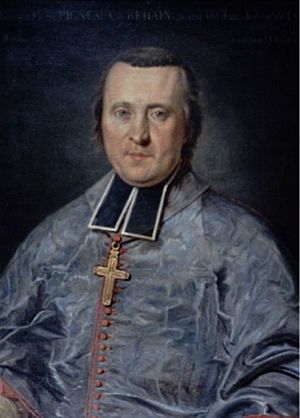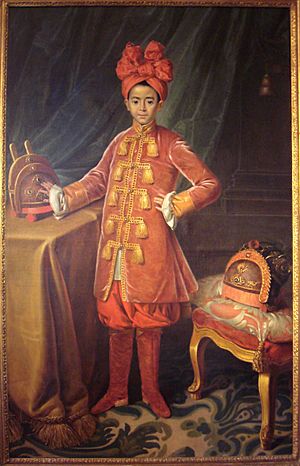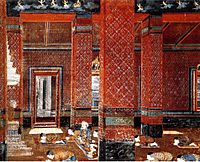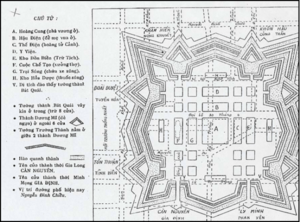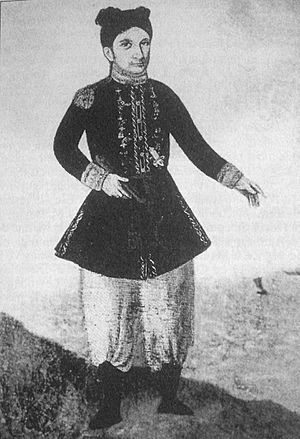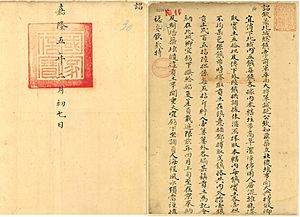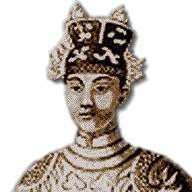Gia Long facts for kids
Quick facts for kids Emperor Gia Long嘉隆帝 |
|||||||||||||||||||||
|---|---|---|---|---|---|---|---|---|---|---|---|---|---|---|---|---|---|---|---|---|---|
 |
|||||||||||||||||||||
| Emperor of Việt Nam | |||||||||||||||||||||
| Reign | 1804–1820 | ||||||||||||||||||||
| Predecessor | Đại Việt renamed to Việt Nam | ||||||||||||||||||||
| Successor | Minh Mang | ||||||||||||||||||||
| Emperor of Đại Việt | |||||||||||||||||||||
| Reign | 1802–1804 | ||||||||||||||||||||
| Predecessor | Nguyễn Quang Toản of Tây Sơn dynasty | ||||||||||||||||||||
| Successor | Đại Việt renamed to Việt Nam | ||||||||||||||||||||
| Regent | Minh Mạng (1818–1820) | ||||||||||||||||||||
| Emperor of Nguyễn dynasty | |||||||||||||||||||||
| Reign | 1802–1820 | ||||||||||||||||||||
| Predecessor | Dynasty established | ||||||||||||||||||||
| Successor | Minh Mạng | ||||||||||||||||||||
| Nguyễn lords | |||||||||||||||||||||
| Reign | 1780–1802 | ||||||||||||||||||||
| Predecessor | Nguyễn Phúc Dương | ||||||||||||||||||||
| Successor | End of Military Commander | ||||||||||||||||||||
| Born | 8 February 1762 Phú Xuân, Đàng Trong, Đại Việt |
||||||||||||||||||||
| Died | 3 February 1820 (aged 57) Imperial City, Huế, Việt Nam |
||||||||||||||||||||
| Burial | Thiên Thọ Tomb | ||||||||||||||||||||
| Spouse | Empress Thừa Thiên Empress Thuận Thiên More than 100 concubines |
||||||||||||||||||||
| Issue | Nguyễn Phúc Cảnh Nguyễn Phúc Đảm 13 other sons and 18 daughters |
||||||||||||||||||||
|
|||||||||||||||||||||
| House | Nguyễn Phúc | ||||||||||||||||||||
| Father | Nguyễn Phúc Luân | ||||||||||||||||||||
| Mother | Nguyễn Thị Hoàn | ||||||||||||||||||||
| Religion | Ruism | ||||||||||||||||||||
Gia Long (born Nguyễn Phúc Ánh or Nguyễn Ánh; 8 February 1762 – 3 February 1820) was a very important leader in Vietnamese history. He founded the Nguyễn dynasty, which was the last royal family to rule Vietnam. His family ruled the country until 1945.
Nguyễn Ánh was a nephew of the last Nguyễn lords who ruled southern Vietnam. In 1777, when he was just 15, his family was killed during the Tây Sơn rebellion. He had to go into hiding. After many ups and downs, he became friends with a French Catholic Bishop named Pierre Pigneau de Behaine. Pigneau helped Nguyễn Ánh get support from France, though it didn't fully work out as planned.
From 1789, Nguyễn Ánh started winning battles again. He marched north to defeat the Tây Sơn forces. By 1802, he had reunited Vietnam after hundreds of years of fighting between different groups. Vietnam became bigger than ever before, stretching from China in the north to the Gulf of Thailand in the south.
Gia Long's rule was known for following Confucianism strictly. He brought back the old Confucian education system. He moved the capital from Hanoi to Huế because more people lived in the south. He also built many strong forts and a beautiful palace in his new capital. With help from French experts, he made Vietnam's defenses much stronger. He allowed Catholic missionaries to work in Vietnam because of his French friends, but his sons were not as tolerant. Under his rule, Vietnam became a powerful country in Southeast Asia. He even made Cambodia a state that paid tribute to Vietnam.
Contents
Early Life and Challenges
Nguyễn Ánh was born in Phú Xuân (which is now Huế) on 8 February 1762. He was the third son of Nguyễn Phúc Luân. His family, the Nguyễn lords, ruled southern Vietnam. However, there were disagreements about who should be the next leader. In 1765, his uncle, Nguyễn Phúc Thuần, became the lord instead of his father. His father was jailed and died that same year.
In 1777, a group called the Tây Sơn brothers (Nguyễn Nhạc, Nguyễn Huệ, and Nguyễn Lữ) rebelled. They killed Lord Thuần and many other Nguyễn family members. Nguyễn Ánh was one of the few high-ranking family members who survived. He had to flee south to places like Saigon and the Mekong Delta. This event changed everything for the Nguyễn family. Nguyễn Ánh had to build a new support network, mostly from people in the south.
He was helped by a Catholic priest named Paul Nghi. Later, he met another French priest, Pigneau de Behaine, who became a very important advisor. Pigneau hoped that by helping Nguyễn Ánh win, the Catholic Church would grow in Vietnam. They had to hide from the Tây Sơn army, even escaping to an island in the Gulf of Thailand.
In late 1777, the Tây Sơn army moved north to fight another group. Nguyễn Ánh secretly returned to the mainland and, with the help of his supporters, took back Saigon. A key commander named Do Thanh Nhon helped him a lot, building an army and defeating Tây Sơn forces. Nguyễn Ánh even sent a message to Thailand to ask for friendship.
In 1780, Nguyễn Ánh declared himself "Nguyễn King" with Nhon's support. However, in 1781, Nguyễn Ánh had Nhon killed. The exact reason is not clear, but some believe Nhon was becoming too powerful. The Tây Sơn leaders were happy about Nhon's death because he was the Nguyễn officer they feared most. Many of Nhon's supporters rebelled, weakening Nguyễn Ánh's army. The Tây Sơn quickly recaptured Saigon. Nguyễn Ánh had to flee again, even escaping a naval attack during a typhoon.
In 1784, Nguyễn Ánh sought help from Thailand, but their combined forces were defeated by the Tây Sơn. This made Nguyễn Ánh realize that relying on Thai military help would not be popular with the Vietnamese people.
French Support and Return to Power
Feeling discouraged, Nguyễn Ánh asked Pigneau to seek help from France. He even sent his eldest son, Nguyễn Phúc Cảnh, with Pigneau to show his trust. Pigneau traveled to India and then to France to ask King Louis XVI for military aid. France was having financial problems before the French Revolution, so it was hard to get support.
Pigneau argued that if France helped Nguyễn Ánh, they could gain control of trade in Asia. In 1787, a treaty was signed between France and Cochinchina (southern Vietnam). France promised ships and soldiers in exchange for land and trade rights. However, the French governor in India was unwilling to fulfill the agreement. So, Pigneau had to use money he raised in France to hire French volunteers and buy weapons.
Meanwhile, Nguyễn Ánh was welcomed by King Rama I in Bangkok, Thailand. His soldiers even helped Thailand in a war against Burma. In 1786, Nguyễn Ánh signed a treaty with the Portuguese, but this made the Thai king distrust him.
Nguyễn Ánh secretly left Thailand and returned to southern Vietnam. He tried to recapture Saigon but failed at first. He eventually persuaded a local leader, Vo Tanh, to join him by giving his sister to him as a wife. After a tough battle, Nguyễn Ánh's soldiers captured Saigon on 7 September 1788. Pigneau arrived in Saigon in 1789 with French volunteers and supplies. This combined force helped Nguyễn Ánh secure his control over southern Vietnam. While some scholars debate the exact number, less than 100 French soldiers and about a dozen officers were present.
Building a Strong Base in the South
After more than ten years of fighting, Nguyễn Ánh finally controlled Saigon long enough to build a strong base. The area around Saigon, called Gia Dinh, became his political center. He rebuilt his army and government. This was the first time southern Vietnam became a strong political region.
In 1788, he created a Council of High Officials and a tax system. Two years later, he started a system where soldiers were given land to farm and defend, which helped build support among all ethnic groups.
French officers hired by Pigneau helped train Nguyễn Ánh's military and brought in Western technology. Jean-Marie Dayot trained the navy and built modern ships. Olivier de Puymanel trained the army, teaching European fighting methods and how to use artillery. Pigneau and other missionaries also bought weapons and supplies for Nguyễn Ánh. Pigneau was a key advisor until he died in 1799. Gia Long honored him greatly, calling him "the most famous foreigner" at his court.
Building Fortifications
After taking back Saigon, Nguyễn Ánh focused on strengthening his defenses. The Tây Sơn had often raided the south for rice. Nguyễn Ánh asked his French officers to design a modern European-style fort in Saigon. This fort was designed by Theodore Lebrun and de Puymanel. About 30,000 people were forced to work on it in 1790, and they were overworked.
When finished, the stone fort was huge, with walls over 4 kilometers long. It was built in a Vauban style, which was very strong. The fort was protected by rivers on three sides. After this fort was built, the Tây Sơn never tried to recapture Saigon by river again. Nguyễn Ánh was very interested in forts and even asked his French advisors to bring back books on the latest building techniques. His royal palace was built inside this strong fort.
Growing the Economy
With the south secure, Nguyễn Ánh focused on farming. The region had suffered from rice shortages due to the long wars. He started a program called đồn điền, which means "military settlement." Soldiers were given tools and grain to clear and farm land. After a few years, they had to pay taxes on their harvest. This program greatly increased the amount of cultivated land and led to large surpluses of grain.
By 1800, this increased farming allowed Nguyễn Ánh to support a large army of over 30,000 soldiers and a navy of more than 1,200 ships. The extra grain was sold to traders to buy materials for the military, like iron and bronze. The government also bought sugar from farmers and traded it for weapons. This food surplus also helped Nguyễn Ánh provide for his people, which made them more loyal. He built granaries along his northward path, so his army could be fed from the south instead of taking food from the areas he was trying to conquer. New regions were given tax breaks, and Tây Sơn officials who surrendered were given similar jobs in Nguyễn's government.
Nguyễn Ánh also improved his navy, which was smaller than the Tây Sơn fleet. In 1781, he tried to get modern European ships, but it didn't go well. In 1789, Pigneau returned with two French ships, which became the base for Nguyễn Ánh's growing navy. Over time, Vietnamese sailors replaced the French and Indian crews. Nguyễn Ánh bought more European ships and built his own. By 1794, his navy included European ships and hundreds of Vietnamese boats. In 1801, his navy was very large, with many different types of ships.
Most of the European-style ships were built in his shipyard in Saigon. Nguyễn Ánh was very involved in the naval program, spending hours at the docks. He even studied naval carpentry and navigation from French books. European travelers praised the Saigon shipyard.
Even though he relied on French officers for technology, Nguyễn Ánh kept his inner military circle Vietnamese. The French often wanted him to attack boldly, but Nguyễn Ánh preferred to move slowly, securing one area before moving to the next. He focused on strengthening his hold on the Gia Dinh area and its rice fields. He also sent missions to other countries to buy more military equipment.
Over time, Nguyễn Ánh gradually reduced the French officers' direct role in battles. By 1801, Vietnamese generals were leading major operations, with French officers mainly helping with supplies.
Unifying Vietnam
In 1792, Nguyễn Huệ, the most famous of the Tây Sơn brothers, died suddenly. Nguyễn Ánh took this chance to attack northwards. Most of the original French soldiers had left by this time. The main fighting happened in central Vietnam, around Nha Trang and Qui Nhơn, which was the Tây Sơn stronghold.
Nguyễn Ánh used his strong, modern navy to raid Tây Sơn coastal areas. His fleet would sail north with the winds and return south when the monsoon ended. The large European ships gave his navy a big advantage with their powerful cannons. Combined with traditional Vietnamese boats and skilled crews, Nguyễn Ánh's navy caused heavy losses for the Tây Sơn.
In 1794, Nguyễn Ánh ordered a fort to be built at Duyen Khanh, near Nha Trang. His son, Nguyễn Phúc Cảnh, and Pigneau defended it. The Tây Sơn tried to capture it but failed. This showed that the Nguyễn forces could now operate in Tây Sơn territory at any time of year, which was a big psychological victory. The Nguyễn then slowly took over the Tây Sơn heartland.
Heavy fighting continued at the fortress of Qui Nhơn. It was captured in 1799 but quickly lost again, then finally regained in 1801. The powerful navy played a key role in recapturing the city. With Qui Nhơn captured, the Tây Sơn's defeat was certain. In June, the central city of Huế, the old Nguyễn capital, fell. Nguyễn Ánh then crowned himself emperor, taking the name Gia Long. He quickly took over the north, capturing Hanoi on 22 July 1802.
After 25 years of fighting, Gia Long had united Vietnam. He became the first Vietnamese ruler to control land from China in the north all the way to the Gulf of Thailand in the south. He then asked China's Qing dynasty for official recognition, which they granted. Because France didn't fully honor their treaty, Vietnam was not forced to give up land or trading rights.
The Tây Sơn had previously massacred many ethnic Chinese people, so most ethnic Chinese supported Nguyễn Ánh against them. This support helped Nguyễn Ánh defeat the Tây Sơn.
Gia Long's Rule
Gia Long's rule was very traditional, following strict Confucian rules. After defeating the Tây Sơn, he canceled their changes and brought back the old Confucian education and government systems. He moved the capital from Hanoi to Huế to match where most of the population lived. He built new forts and a palace in Huế. With French help, he modernized Vietnam's military. He allowed Catholic missionaries to work in Vietnam out of respect for his French friends, but his successors were less tolerant. Under Gia Long, Vietnam became militarily strong in Southeast Asia, even making Cambodia a state that paid tribute to Vietnam. However, he generally kept Vietnam isolated from European powers.
Renaming the Country
Gia Long decided to join the Chinese tributary system. He sent a message to Qing China and asked to change his country's name to Nam Việt. He explained that this name combined "An Nam" and "Việt Thường," two ancient names for northern and southern Vietnam, to show the country was united. The Chinese emperor refused because "Nam Việt" was the name of an ancient kingdom that included parts of China. Instead, he agreed to change it to Việt Nam.
Gia Long also copied the Chinese imperial system. In 1805, he even used the term "Trung Quốc" (meaning "Middle Kingdom," often used for China) to refer to Vietnam. He believed there should be clear borders between Vietnamese and other groups like the Khmer.
Government Structure

During the war, Nguyễn Ánh had started a small government. Because of the constant fighting, military officers were the most important people around him. This continued throughout his rule. Vietnam was divided into three main regions. The central part, around Huế, was directly ruled by Gia Long. The government in Huế had six ministries: Public affairs, finance, rites, war, justice, and public works.
Gia Long was careful with the northern and southern regions, not wanting to change things too quickly after centuries of division. In the north, old officials from the previous Lê government stayed in power. In the south, Saigon was the capital of four provinces. This system allowed Gia Long to reward his loyal supporters with powerful positions, giving them a lot of freedom in local matters. This system lasted until 1831–32, when his son, Minh Mạng, made the government more centralized.
Gia Long was not seen as very innovative in his administration. He preferred traditional ways. When he united the country, it was described as chaotic: government systems were broken, officials were missing, taxes weren't collected, and roads and public buildings were not maintained. Justice was difficult, and pirates were a problem.
Foreign Relations
For centuries, the Cambodian empire had been weak, and Vietnamese people had moved into the Mekong Delta, which was once Khmer land. Cambodia was often invaded by both Vietnam and Thailand. In 1807, the Cambodian king, Ang Chan, asked Gia Long to formally recognize him as a vassal (a ruler who pays tribute to a more powerful one). Gia Long sent an ambassador with a special book and a silver seal.
In 1812, Ang Chan's brother rebelled, and Thailand sent troops to support him, hoping to gain control over Cambodia. In 1813, Gia Long sent a large army that forced the Thai and the rebel prince out of Cambodia. After this, a Vietnamese army was permanently stationed in the Cambodian capital, Phnom Penh. Thailand did not try to control Cambodia again during Gia Long's rule.
France, under Napoleon, was busy with wars in Europe, so their plans to use Vietnam as a base never happened. However, France remained the only European power with people living in Vietnam during Gia Long's reign.
Trade Policies
Because Pigneau's deal with France didn't fully happen, Gia Long was able to keep his country mostly closed to Western trade. He generally didn't want to make special trade deals with European countries. In 1804, a British group tried to get trading rights, but Gia Long refused. He had bought weapons from British companies on credit, which led to the British sending a diplomat, John Roberts, to Huế. However, Roberts's gifts were rejected, and no trade deal was made. The British also asked for exclusive trading rights and an island, but Gia Long said no. The Dutch also tried and failed. These failures were blamed on the influence of the French officials in Gia Long's court.
Gia Long kept four French officers in his service after he became emperor: Philippe Vannier, Jean-Baptiste Chaigneau, de Forsans, and the doctor Despiau. They became high-ranking officials and were treated very well, with bodyguards and nice homes. They didn't even have to bow before the emperor.
Domestic Improvements
Gia Long ended the practice of princes and nobles owning large amounts of land. He also stopped the 800-year-old tradition of paying officials with taxes from villages. He repaired old highways and built new ones, including a major north-south road. He set up a postal service and built public storehouses to help people during droughts. Gia Long also reformed the money system and tried to improve farming. However, the population grew faster than new land could be farmed.
Even though the civil war was over, Gia Long decided to build more forts. He was convinced they were effective. During his 18-year reign, 11 more forts were built across the country. Most were in the strong Vauban style. Vietnamese engineers designed and oversaw the construction. Gia Long's fort-building program was criticized because people had to work very hard, sometimes day and night, and some farmland was left uncultivated. There were also complaints about corruption and high taxes. After his coronation, Gia Long greatly reduced his navy due to the high cost of building forts and roads. However, in 1819, he started a new shipbuilding program, personally overseeing the shipyards.
Social Policies
To train government officials, Gia Long brought back the Confucian court examinations that the Tây Sơn had stopped. In 1803, he founded the National Academy in Huế to educate the sons of officials and talented students in classical Confucian literature. In 1804, he set up similar schools in the provinces. The goal was to create loyal administrators who were educated in classical texts.
In 1807, Gia Long held the first civil service examinations under the Nguyễn dynasty. These exams focused on Chinese history and Confucian texts.
Gia Long also created a new legal code, the Gia Long Code, in 1815. While he said it was a mix of older Vietnamese and Chinese laws, most scholars believe it was almost a complete copy of the Chinese Qing code. This code focused on strengthening the power of the emperor, his officials, and the traditional family. For serious crimes, especially against the state, the whole family of the criminal could be punished, even with death.
With Vietnam united, Gia Long moved the capital from Hanoi to Huế. He rebuilt the old fort of Phú Xuân into a strong fortress. It was a square shape, 2.5 km on each side, with high walls and moats. The new palace and court customs were directly copied from Chinese styles, and his palace was meant to be a smaller version of China's Forbidden City.
Gia Long allowed Catholic missionaries to work freely out of respect for his French helpers. However, he was unhappy that Catholics condemned traditional ancestor worship, which is a key part of Vietnamese culture. Gia Long also didn't like Buddhism, even though most people practiced it. He often limited Buddhist activities.
In August 1802, Gia Long took revenge on the Tây Sơn leaders who had killed his family in the 1770s. The remaining Tây Sơn family members and generals were executed. The bodies of Quang Trung and his queen were dug up and disrespected. His son, the last Tây Sơn ruler, Nguyễn Quang Toản, was tied to four elephants and torn apart. Gia Long reversed all the changes Quang Trung had made, bringing back the old Confucian ways. This meant the civil service became more important than the army, and Confucian studies were valued over science in education.
Family and Successor
Gia Long had many wives. His most famous wives were Empress Thừa Thiên and Empress Thuận Thiên. In 1780, he married Tống Thị Lan, who gave birth to two sons, including Crown Prince Nguyễn Phúc Cảnh. She was later given the title Empress Thừa Thiên. Around 1781, he married Trần Thị Đang, who had three sons, including Nguyễn Phúc Đảm. She was later given the title Empress Thuận Thiên. After conquering Vietnam, Gia Long married Lê Ngọc Bình, a daughter of the previous Lê dynasty emperor. She had been married to the Tây Sơn leader Quang Toản, but Gia Long took her as his wife after defeating him. Gia Long also had almost 100 other wives, who were daughters of his officials. He did this to ensure the loyalty of his inner circle.
Crown Prince Nguyễn Phúc Cảnh died from smallpox during the war. It was expected that Cảnh's son would become emperor. However, in 1816, Gia Long chose Nguyễn Phúc Đảm, the son of his second wife, to be his successor. Gia Long chose him because he was strong and did not like Westerners, unlike Cảnh's family who had become Catholic and were less traditional. Before becoming emperor, Nguyễn Phúc Đảm reportedly praised Japan for getting rid of Christianity. Gia Long told his son to treat Europeans with respect, especially the French, but not to give them too much power. Gia Long died on 3 February 1820 and was buried at the Thien Tho Tomb.
See also
 In Spanish: Gia Long para niños
In Spanish: Gia Long para niños
- Nguyễn Phúc Cảnh
- Minh Mạng


